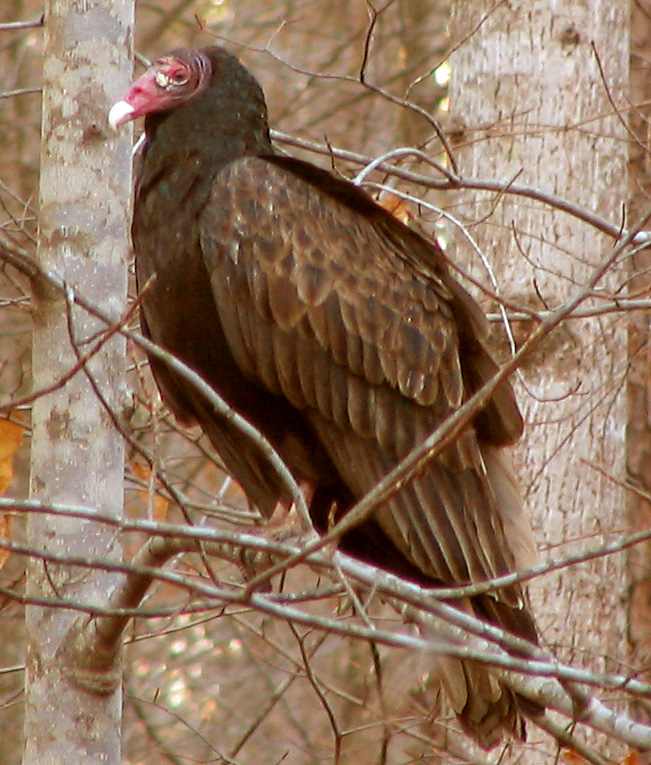- Cathartes
Taxobox
name = Cathartes

image_width = 200px
image_caption = Turkey Vulture in woods
regnum =Animal ia
phylum = Chordata
classis = Aves
ordo = "Incertae sedis " (disputed)
familia =Cathartidae
genus = "Cathartes"
genus_authority = Illiger, 1811
subdivision_ranks = Species
subdivision =Turkey Vulture ("Cathartes aura")Greater Yellow-headed Vulture ("Cathartes melambrotus")Lesser Yellow-headed Vulture ("Cathartes burrovianus")The genus Cathartes (Greek for "purifier") includes medium-sized to large carrion-feeding birds in the
New World vulture (Cathartidae) family. There are 3 species currently classified in thisgenus . "Cathartes" vultures occur widely in theAmericas .While all species obtain a majority of their diet by scavenging, the Lesser Yellow-headed Vulture is known to hunt live prey in wetland environments.
All "Cathartes" species have featherless heads with brightly colored skin (yellow to orange in the yellow-headed vultures, bright red in the
Turkey Vulture ).Systematics
"Cathartes" is the only genus in its family which is not
monotypic .The exact
taxonomic placement of this genus and the remaining species ofNew World Vulture s remains unclear. Though both are similar in appearance and have similar ecological roles, the New World andOld World Vultures evolved from different ancestors in different parts of the world. Just how different the two are is currently under debate, with some earlier authorities suggesting that the New World vultures are more closely related tostorks . [Sibley, Charles G. and Burt L. Monroe. 1990. " [http://books.google.com/books?vid=ISBN0300049692 Distribution and Taxonomy of the Birds of the World] ". Yale University Press. ISBN 0-300-04969-2. Accessed 2007-04-11.] More recent authorities maintain their overall position in the orderFalconiformes along with the Old World Vultures [Sibley, Charles G., and Jon E. Ahlquist. 1991. " [http://books.google.com/books?vid=ISBN0300040857 Phylogeny and Classification of Birds: A Study in Molecular Evolution] ". Yale University Press. ISBN 0-300-04085-7. Accessed 2007-04-11.] or place them in their own order, Cathartiformes. [Ericson, Per G. P.; Anderson, Cajsa L.; Britton, Tom; Elżanowski, Andrzej; Johansson, Ulf S.; Kallersjö, Mari; Ohlson, Jan I.; Parsons, Thomas J.; Zuccon, Dario & Mayr, Gerald (2006): Diversification of Neoaves: integration of molecular sequence data and fossils. "Biology Letters " online: 1-5. DOI|10.1098/rsbl.2006.0523 [http://www.systbot.uu.se/staff/c_anderson/pdf/neoaves.pdf PDF preprint] [http://royalsociety.metapress.com/media/public/contributionsupplementalmaterials/0/5/8/3/058352377848735w/archive1.pdf Electronic Supplementary Material] (PDF)] TheSouth American Classification Committee has removed the New World Vultures fromCiconiiformes and instead placed them in "Incertae sedis ", but notes that a move to Falconiformes or Cathartiformes is possible.Remsen, J. V., Jr.; C. D. Cadena; A. Jaramillo; M. Nores; J. F. Pacheco; M. B. Robbins; T. S. Schulenberg; F. G. Stiles; D. F. Stotz & K. J. Zimmer. 2007. [http://www.museum.lsu.edu/~Remsen/SACCBaseline.html "A classification of the bird species of South America."] South American Classification Committee. Retrieved on 2007-10-15]References
Howell, Steve N.G., and Sophie Webb. "A Guide to the Birds of Mexico and Northern Central America." Oxford University Press, New York, 1995. (ISBN 0-19-854012-4)
Wikimedia Foundation. 2010.
